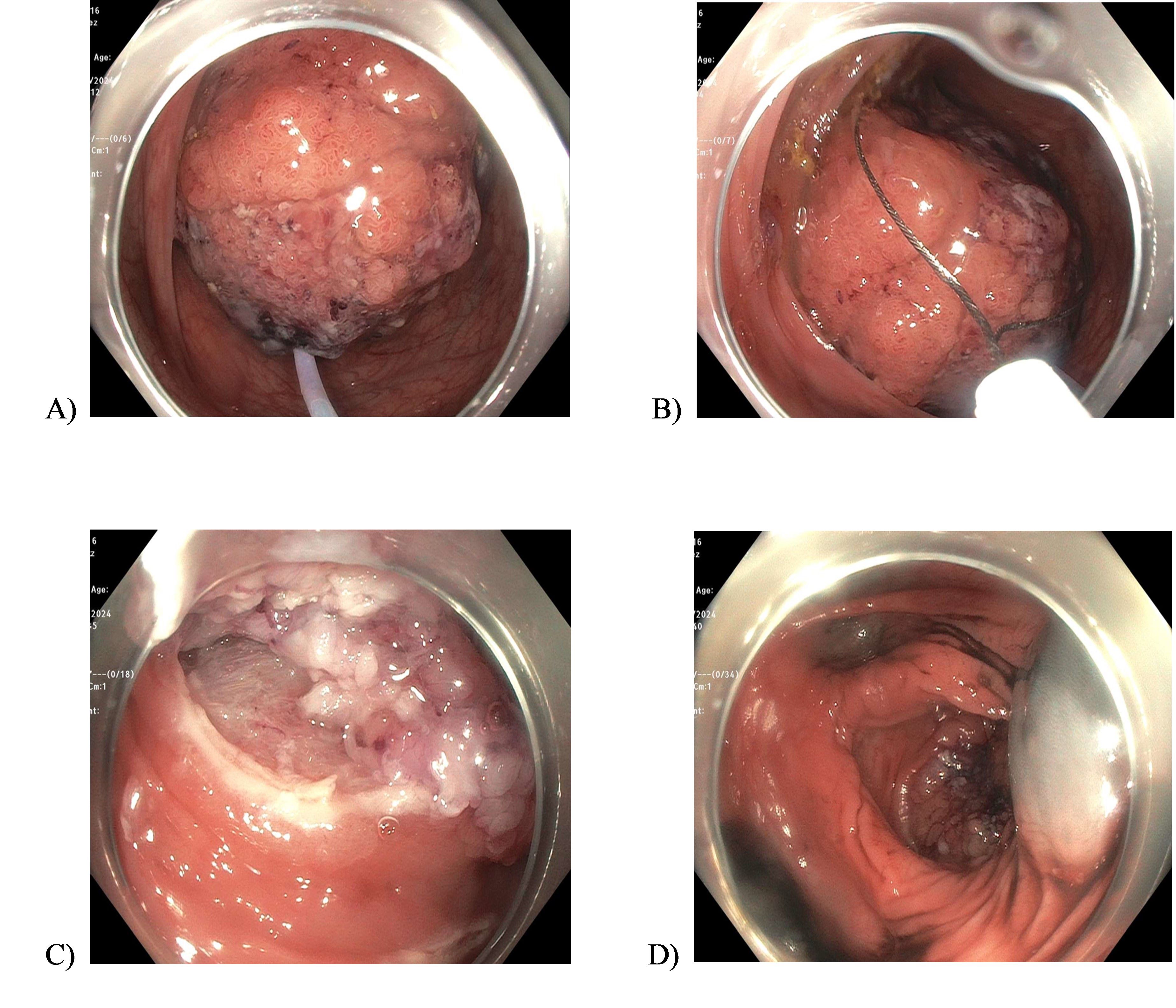Tuesday Poster Session
Category: Interventional Endoscopy
P4518 - Trapped: Endoscopic Management of Snare Entrapment During Polypectomy
Tuesday, October 29, 2024
10:30 AM - 4:00 PM ET
Location: Exhibit Hall E

Has Audio

Akshita Gupta, MBBS
Icahn School of Medicine at Mount Sinai
New York, NY
Presenting Author(s)
Akshita Gupta, MBBS, Manasi Agrawal, MD, Brijen Shah, MD, Nicholas Hoerter, MD
Icahn School of Medicine at Mount Sinai, New York, NY
Introduction: Hot snare polypectomy is a common procedure which although generally safe, has risk of complications. Snare entrapment is a rare, serious complication that requires immediate intervention, with few cases reported in literature. This case report discusses the management of an entrapped snare during a colonoscopy in an ambulatory center.
Case Description/Methods: A 45-year-old woman (BMI 38), with no relevant family history presented for initial screening colonoscopy. During the procedure, a large mobile pedunculated polyp was identified in the descending colon at 40 cm from the anal verge. While attempting hot snare polypectomy the snare became entrapped in the base of the polyp and could not be extricated, showing no thermal effect with cautery. Hence, to transfer care to an advanced endoscopist in a hospital, the snare handle was cut and the scope was withdrawn over the snare catheter, which was taped to the patient’s buttock to prevent dislodgement. On subsequent colonoscopy, a > 5cm polypoid lesion (Paris classification Is) with the embedded snare was identified. Piecemeal mucosal resection (PMR) using a hot snare with Roth net retrieval was performed. After 90 minutes, the snare was successfully removed, but > 50% polyp tissue remained. Given size and concern for malignancy, the polyp was not resected further and its location was marked with a tattoo. The patient was discharged the same day without complications. Pathology revealed tubulovillous adenoma with high grade dysplasia. The patient subsequently underwent laparoscopic subtotal colectomy, final pathology revealing a 7 cm polyp with moderately differentiated adenocarcinoma invading the submucosa.
Discussion: Snare entrapment during polypectomy is a rare but serious complication. Our case demonstrates entrapment in a large, broad-based polyp later identified as invasive cancer. Management options described in rare case reports include allowing the snare to fall off on its own, endoscopic techniques like needle knife and zip-line technique, and surgical intervention. We describe a safe and effective way of endoscopic management with PMR especially useful when large polyp size and high BMI hindered electrocautery. While PMR has a higher recurrence risk, en-bloc resection of large or complex lesions poses higher risk of adverse events like perforation and bleeding. This case highlights factors to consider during polypectomy of high-risk lesions and proposes strategies to address serious complications such as snare entrapment (Table 1).

Note: The table for this abstract can be viewed in the ePoster Gallery section of the ACG 2024 ePoster Site or in The American Journal of Gastroenterology's abstract supplement issue, both of which will be available starting October 27, 2024.
Disclosures:
Akshita Gupta, MBBS, Manasi Agrawal, MD, Brijen Shah, MD, Nicholas Hoerter, MD. P4518 - Trapped: Endoscopic Management of Snare Entrapment During Polypectomy, ACG 2024 Annual Scientific Meeting Abstracts. Philadelphia, PA: American College of Gastroenterology.
Icahn School of Medicine at Mount Sinai, New York, NY
Introduction: Hot snare polypectomy is a common procedure which although generally safe, has risk of complications. Snare entrapment is a rare, serious complication that requires immediate intervention, with few cases reported in literature. This case report discusses the management of an entrapped snare during a colonoscopy in an ambulatory center.
Case Description/Methods: A 45-year-old woman (BMI 38), with no relevant family history presented for initial screening colonoscopy. During the procedure, a large mobile pedunculated polyp was identified in the descending colon at 40 cm from the anal verge. While attempting hot snare polypectomy the snare became entrapped in the base of the polyp and could not be extricated, showing no thermal effect with cautery. Hence, to transfer care to an advanced endoscopist in a hospital, the snare handle was cut and the scope was withdrawn over the snare catheter, which was taped to the patient’s buttock to prevent dislodgement. On subsequent colonoscopy, a > 5cm polypoid lesion (Paris classification Is) with the embedded snare was identified. Piecemeal mucosal resection (PMR) using a hot snare with Roth net retrieval was performed. After 90 minutes, the snare was successfully removed, but > 50% polyp tissue remained. Given size and concern for malignancy, the polyp was not resected further and its location was marked with a tattoo. The patient was discharged the same day without complications. Pathology revealed tubulovillous adenoma with high grade dysplasia. The patient subsequently underwent laparoscopic subtotal colectomy, final pathology revealing a 7 cm polyp with moderately differentiated adenocarcinoma invading the submucosa.
Discussion: Snare entrapment during polypectomy is a rare but serious complication. Our case demonstrates entrapment in a large, broad-based polyp later identified as invasive cancer. Management options described in rare case reports include allowing the snare to fall off on its own, endoscopic techniques like needle knife and zip-line technique, and surgical intervention. We describe a safe and effective way of endoscopic management with PMR especially useful when large polyp size and high BMI hindered electrocautery. While PMR has a higher recurrence risk, en-bloc resection of large or complex lesions poses higher risk of adverse events like perforation and bleeding. This case highlights factors to consider during polypectomy of high-risk lesions and proposes strategies to address serious complications such as snare entrapment (Table 1).

Figure: Figure 1: A) Large polypoid lesion in the descending colon with snare embedded in it
B) Piecemeal mucosal resection (PMR) using hot snare to debulk the tissue and remove the entrapped snare
C) Polyp after 90 mins of PMR
D) Tattoo placed distal to the polyp site for marking
B) Piecemeal mucosal resection (PMR) using hot snare to debulk the tissue and remove the entrapped snare
C) Polyp after 90 mins of PMR
D) Tattoo placed distal to the polyp site for marking
Note: The table for this abstract can be viewed in the ePoster Gallery section of the ACG 2024 ePoster Site or in The American Journal of Gastroenterology's abstract supplement issue, both of which will be available starting October 27, 2024.
Disclosures:
Akshita Gupta indicated no relevant financial relationships.
Manasi Agrawal indicated no relevant financial relationships.
Brijen Shah indicated no relevant financial relationships.
Nicholas Hoerter: Redesign Health – Stock-privately held company.
Akshita Gupta, MBBS, Manasi Agrawal, MD, Brijen Shah, MD, Nicholas Hoerter, MD. P4518 - Trapped: Endoscopic Management of Snare Entrapment During Polypectomy, ACG 2024 Annual Scientific Meeting Abstracts. Philadelphia, PA: American College of Gastroenterology.
